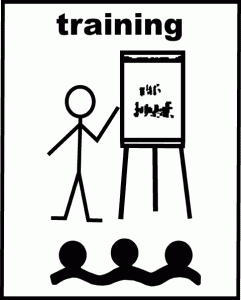The Devil is in the Details…Hazardous Waste Training Requirements

In this series on hazardous waste we have discussed: defining hazardous waste; managing hazardous waste at home; determining generator status; hazardous waste accumulation and storage requirements. This article will review training requirements, one of the biggest violations that companies incur. The amount and type of training required is based upon the generator status of the company. To review our discussion in The Devil is in the Details…What Type of Generator Are You?, the Resource Conservation and Recovery Act (RCRA) defines three type of generators: Conditionally Exempt Small Quantity Generators (CSQG), Small Quantity Generators (SQG), and Large Quantity Generators.
LQGs always have the most comprehensive legal requirements and training is no exception. LQGs must ensure that personnel responsible for hazardous waste management have training within six months of their initial assignment and annually thereafter. The training must meet the requirements defined in Title 40 of the Code of Federal Regulations (40 CFR) 265.16 which include:
- Information that ensures compliance with the RCRA regulations (i.e. generator status, satellite accumulation requirements, main accumulation requirements, hazardous waste determination, container labeling requirements, weekly inspections, etc.)
- Instruction on hazardous waste management including contingency plan implementation (i.e. internal procedures and/or requirements)
- Procedures on effectively responding to hazardous waste emergencies (i.e. inspecting, repairing, and replacing facility emergency and monitoring equipment; communications or alarm systems; response to fires, explosions, land/ground-water contamination incidents; etc.).
SQGs must meet the training requirement specified in 40 CFR 262.34(d)(5) which is very general: “the generator must ensure that all employees are thoroughly familiar with proper waste handling and emergency procedures, relevant to their responsibilities during normal facility operations and emergencies”. In essence, a SQG can provide general training to employees who manage hazardous waste including facility specific procedures for waste handling and emergency response.
A facility with a CSQG generator status is not legally required to conduct training however, training for hazardous waste management is a recommended best practice regardless of generator status as it assists with proper waste management throughout a facility.
All generators, regardless of status, must comply with the U.S. Department of Transportation (DOT) shipping requirements. We will discuss DOT training requirements further in an upcoming article.
When implementing training, one of the biggest challenges is identifying all the employees or personnel who have hazardous waste responsibilities within an organization—a learning management system (LMS) or a training assessment matrix are effective tools used to assist with this process.
Does your company have an effective process or tool to identify employees who have hazardous waste responsibilities? If so, share your best practices with a comment below?
